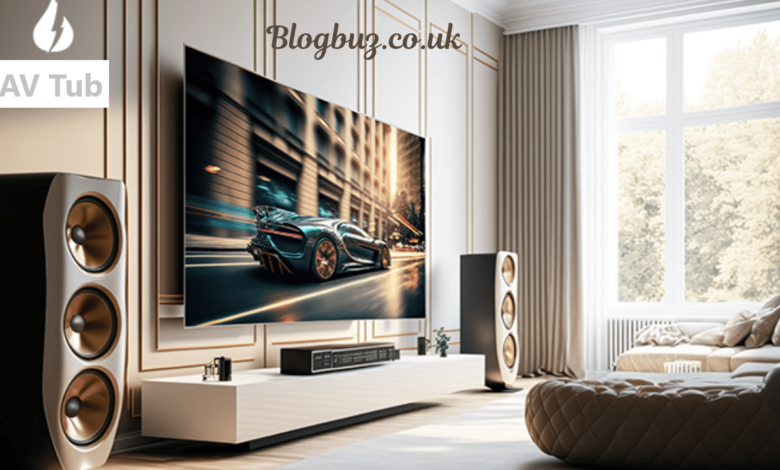AV Tub: Revolutionizing Home Entertainment

“AV tub” (Audio-Visual tub) has become synonymous with cutting-edge home entertainment systems. These advanced devices integrate high-quality audio and visual components to deliver an immersive experience, transforming media consumption. This article thoroughly summarizes this innovative technology and thoroughly explores AV tubs’ evolution, components, applications, and upcoming developments.
The Evolution of AV Tubs
Historical Background
The concept of immersive entertainment dates back several decades. Early attempts to create surround sound systems in The 1970s prepared the way for later developments. The term “AV tub” emerged in the early 2000s, initially describing large, tub-shaped structures equipped with state-of-the-art audio and visual components. These early models were rudimentary but paved the way for today’s sophisticated systems.
Modern Advancements
Modern AV tubs have evolved significantly, integrating 8K resolution, object-based audio, haptic feedback, and AI integration features. These advancements have enhanced the immersive experience, making AV tubs the centerpiece of modern home entertainment.
Core Components of AV Tubs
High-Resolution Screens
AV tubs feature high-resolution screens, often 8K, which provide unparalleled clarity and detail. Combined with HDR (High Dynamic Range) technology, these screens offer vibrant colors and enhanced contrast, bringing content to life like never before.
Advanced Audio Systems
Gone are the days of basic stereo setups. Modern AV tubs use object-based audio systems that dynamically adjust sound output based on the listener’s position. This technology creates a three-dimensional audio experience, immersing the viewer in the action.
Signal Processors and Decoders
Signal processors and audio/video decoders play a crucial role in synchronizing audio and visual outputs. These components ensure that the timing and fidelity of audio and video are perfectly aligned, providing a seamless experience.
Haptic Feedback
Some AV tubs incorporate haptic feedback technology, which simulates physical sensations through vibrations and tactile feedback. This feature gives the product an additional depth of viewing experience, engaging multiple senses simultaneously.
AI Integration
Artificial intelligence is revolutionizing AV tubs by analyzing viewing habits and preferences. AI-powered algorithms automatically tailor recommendations and optimize settings, ensuring a personalized and hassle-free experience.
Applications of AV Tubs
Home Entertainment
AV tubs are primarily used for home entertainment, offering a rich experience for movies, gaming, and music. By combining the capabilities of several devices into one, AV tubs reduce clutter and simplify the user experience.
Education and Training
AV tubs enhance learning experiences in educational settings by providing interactive and engaging audio-visual content. They are used in virtual classrooms and professional training sessions to help students and professionals grasp complex concepts more effectively.
Healthcare and Public Service
AV tubs provide therapeutic visual and audio stimuli in healthcare, improving patient care. They are also used in public service for effective communication and information dissemination.
Advantages of AV Tubs
Consolidation and Space Economy
One of the most apparent advantages of AV tubs is reduced physical clutter. Integrating multiple functions into a single tub saves space and eliminates the need for numerous devices and cables.
Harmonization of Audio and Video
The integration of audio and video functions ensures these components work together, resulting in perfectly synchronized experiences. This alignment is crucial for high-frame-rate and virtual reality content, where lag can disrupt the immersion.
Seamless User Interface
AV tubs offer a single point of control for audio and video settings, simplifying user interaction. This harmonious interface reduces complexity for casual users while providing in-depth customization options for audiophiles and cinephiles.
Challenges and Future Trends
Compatibility and Ecosystem Integration
Ensuring AV tubs are compatible with existing devices and emerging standards is a significant challenge. Open standards and APIs can help bridge this gap, allowing for integration with smart home systems, streaming platforms, and other services.
Power and Heat Management
The high demands of audio and video processing require effective power management strategies. Balancing energy efficiency with performance is crucial, as is developing cooling systems that maintain optimal operating temperatures without being intrusive.
Market Education and Perception
Consumer education is vital for the widespread adoption of AV tubs. Demonstrating their superior performance and convenience over traditional setups is essential for market penetration.
The Future of AV Tubs
Trends Shaping the Future
The future of AV tubs lies in increased integration with AI and smart home systems. These trends will likely influence the design and capabilities of future AV tubs, opening new possibilities for deployment and integration.
Anticipating Technological Leaps
Future AV tubs could leverage AI and machine learning to offer predictive and adaptive response capabilities, recalibrating real-time audio and video parameters to match content and environment.
Holistic Audio-Visual Ecosystem
As AV tubs evolve, they will likely become central nodes in a more extensive, interconnected web of audio-visual devices. This ecosystem approach will redefine what it means to deliver a complete media experience.
Conclusion
AV tubs represent the pinnacle of immersive home entertainment technology. With their high-resolution screens, advanced audio systems, haptic feedback, and AI integration, they offer an unparalleled audio-visual experience. The future looks promising, while compatibility, power management, and market education remain. As AV tubs evolve, they will play an increasingly central role in our entertainment, education, and healthcare landscapes, transforming how we interact with media.
FAQs on AV Tub
What is an AV tub?
An AV tub, or Audio-Visual tub, is an advanced home entertainment system that integrates high-quality audio and visual components to deliver an immersive media experience. These systems often feature high-resolution screens, advanced audio setups, haptic feedback, and AI integration.
What are the critical components of modern AV tubs?
Modern AV tubs include high-resolution screens (often 8K), advanced audio systems with object-based sound, signal processors and decoders, haptic feedback technology, and AI integration.
How does AI integration benefit AV tubs?
Modern AV tubs include high-resolution screens (often 8K), advanced audio systems with object-based sound, signal processors and decoders, haptic feedback technology, and AI integration.
What are some typical applications of AV tubs?
AV tubs are primarily used for home entertainment but also enhance learning experiences in education and training and provide therapeutic visual and audio stimuli in healthcare and public service settings.
What are the advantages of using an AV tub?
Advantages include consolidation and space economy by reducing physical clutter, harmonizing audio and video for perfectly synchronized experiences, and a seamless user interface that simplifies interaction.
You May Also Read: Streaming Elevated: The Allure of JSBLE.TV




